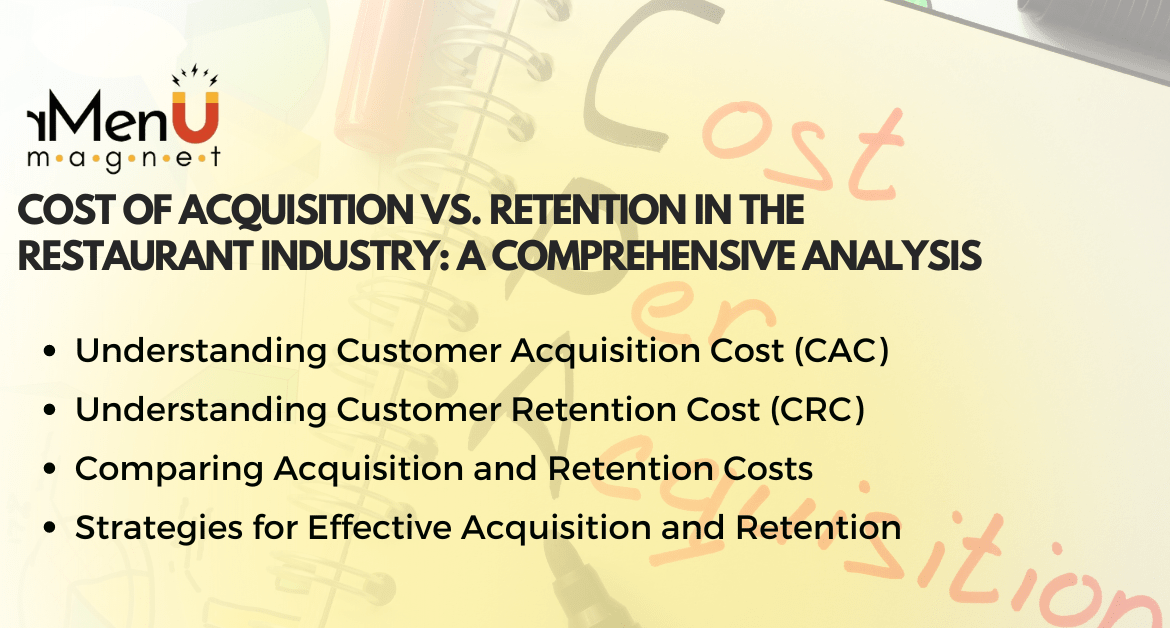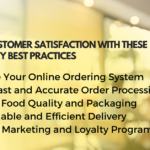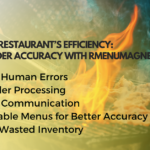Table Of Contents
In the competitive world of the restaurant industry, understanding the balance between acquiring new customers and retaining existing ones is crucial for long-term success. Both strategies have their own merits and costs, and optimizing them can significantly impact a restaurant’s profitability. This blog explores the cost of acquisition versus retention and provides insights into how restaurants can effectively manage both to thrive in the industry.
Understanding Customer Acquisition Cost (CAC)
Customer Acquisition Cost (CAC) refers to the total expense incurred to attract a new customer to your restaurant. This includes marketing expenses, promotional offers, discounts, and any other costs associated with bringing a new customer through your doors.
Factors Affecting CAC:
- Marketing Channels: Digital marketing, social media campaigns, traditional advertising, and partnerships all come with different costs.
- Promotional Offers: Discounts, special deals, and introductory offers can increase CAC but are often necessary to attract new patrons.
- Brand Awareness: Establishing a brand presence can be costly but is essential for drawing in first-time customers.
- Competition: The level of competition in your area can drive up marketing costs as you vie for customers’ attention.
Understanding Customer Retention Cost (CRC)
Customer Retention Cost (CRC) involves the expenses related to keeping existing customers coming back. This can include loyalty programs, personalized marketing, exceptional customer service, and other retention strategies.
Factors Affecting CRC:
- Loyalty Programs: Offering rewards and incentives for repeat business.
- Personalized Marketing: Targeted communication based on customer preferences and behaviors.
- Customer Experience: Investing in staff training and service improvements to enhance the dining experience.
- Feedback Systems: Implementing systems to gather and act on customer feedback, ensuring continuous improvement.
Comparing Acquisition and Retention Costs
Cost Comparison: Typically, acquiring new customers is more expensive than retaining existing ones. Studies have shown that it can cost five times more to attract a new customer than to keep an existing one. This highlights the importance of focusing on customer retention to maximize profitability.
Revenue Impact: Retained customers often spend more and generate higher revenue over time. They are more likely to try new menu items, participate in loyalty programs, and refer others to your restaurant, contributing to organic growth.
Strategies for Effective Acquisition and Retention
Balancing Acquisition and Retention:
- Targeted Marketing: Use data analytics to identify and target potential customers effectively. Leverage social media, online reviews, and local events to increase visibility.
- Exceptional Service: Ensure that every customer has a memorable dining experience, encouraging them to return and spread positive word-of-mouth.
- Loyalty Programs: Implement programs that reward repeat visits, such as discounts, exclusive offers, and points systems.
- Personalization: Utilize customer data to personalize marketing efforts and enhance the customer experience.
- Feedback and Improvement: Regularly collect and act on customer feedback to continuously improve your offerings and service.
Case Study: Successful Restaurant A mid-sized restaurant implemented a balanced strategy focusing on both acquisition and retention. They invested in a robust online presence, targeted local advertising, and partnered with food delivery services to attract new customers. Simultaneously, they launched a loyalty program offering discounts and special deals to regular customers. The result was a 20% increase in new customers and a 35% rise in repeat business within a year.
In the restaurant industry, balancing the costs of customer acquisition and retention is key to sustainable growth and profitability. While attracting new customers is essential, retaining existing ones is often more cost-effective and profitable in the long run. By implementing targeted marketing, providing exceptional service, and fostering loyalty, restaurants can optimize both strategies and achieve long-term success.




